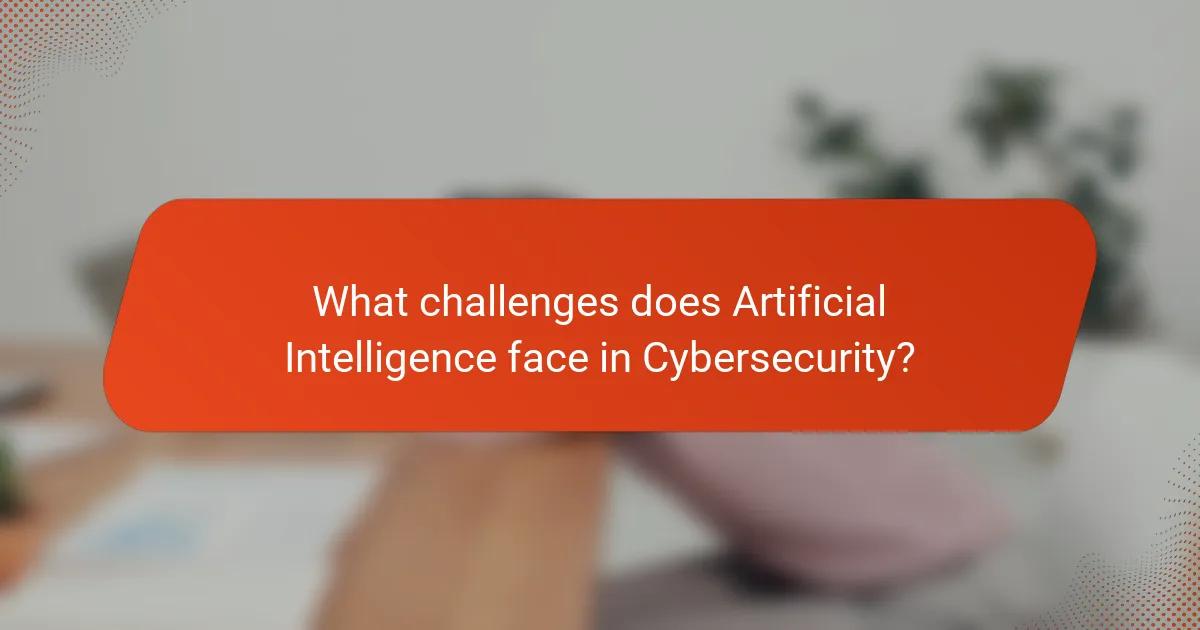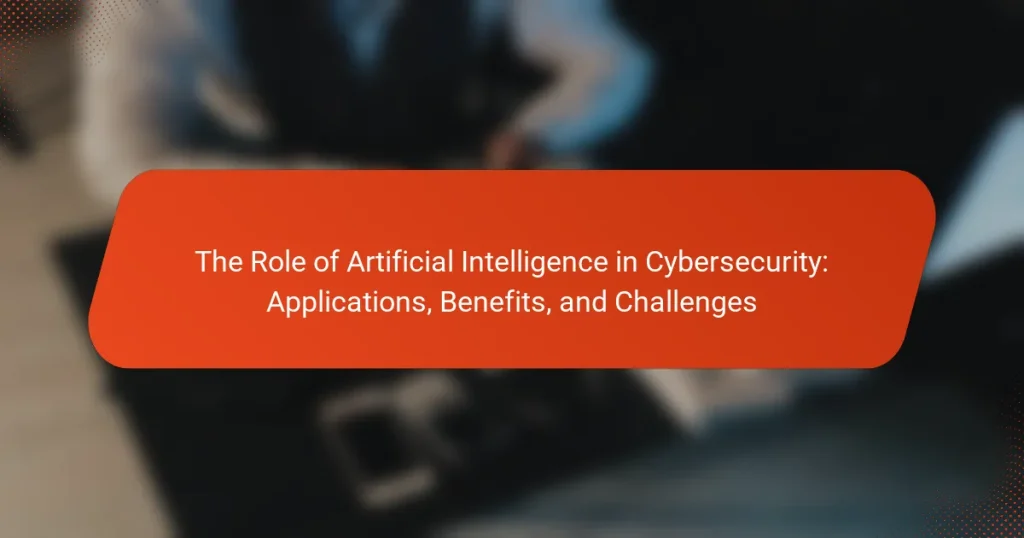Artificial Intelligence (AI) significantly enhances Cybersecurity by improving threat detection and response capabilities. AI algorithms analyze extensive data sets to identify patterns that indicate cyber threats, allowing for quicker anomaly detection in network traffic and automated incident responses. While AI offers substantial benefits, such as an 80% reduction in breach detection time, it also faces challenges, including the evolving nature of cyber threats, data quality issues, and potential false positives. Future trends indicate that AI will continue to evolve, utilizing machine learning for real-time threat analysis and integrating with technologies like blockchain to bolster security measures.

What is the role of Artificial Intelligence in Cybersecurity?
Artificial Intelligence plays a crucial role in Cybersecurity by enhancing threat detection and response. AI algorithms analyze vast amounts of data to identify patterns indicative of cyber threats. These systems can detect anomalies in network traffic, which may signal potential breaches. AI also automates responses to security incidents, reducing the time to mitigate threats. According to a report by McKinsey, organizations using AI for cybersecurity can reduce the average time to detect a breach by 80%. Additionally, AI enhances predictive analytics, allowing for proactive measures against emerging threats. This capability is essential as cyber threats continue to evolve in complexity and frequency.
How does Artificial Intelligence enhance cybersecurity measures?
Artificial Intelligence enhances cybersecurity measures by automating threat detection and response. AI algorithms analyze vast amounts of data in real-time. They identify patterns that indicate potential security breaches. Machine learning models improve their accuracy over time by learning from new data. AI can also predict and prevent attacks by assessing vulnerabilities. This proactive approach reduces response times significantly. According to a report by McKinsey, organizations using AI in cybersecurity saw a 30% reduction in incident response times. Additionally, AI-driven tools can adapt to evolving threats more effectively than traditional methods.
What specific technologies are involved in AI-driven cybersecurity?
AI-driven cybersecurity involves several specific technologies. These include machine learning algorithms, which analyze data patterns for threat detection. Natural language processing (NLP) is used to interpret and respond to security alerts. Behavioral analytics identifies anomalies in user behavior to prevent breaches. Automated response systems react to threats in real-time, minimizing damage. Threat intelligence platforms aggregate data from various sources to predict attacks. Additionally, deep learning enhances the accuracy of threat detection through complex data analysis. These technologies work together to create a robust cybersecurity framework.
How do these technologies improve threat detection?
Artificial intelligence technologies improve threat detection by analyzing vast amounts of data quickly. They utilize machine learning algorithms to identify patterns indicative of cyber threats. These algorithms can learn from previous attacks, enhancing their predictive capabilities. AI systems can adapt to new threats in real-time, reducing response times. According to a report by Gartner, AI-driven security solutions can reduce incident response times by up to 90%. This efficiency allows organizations to mitigate risks more effectively. Furthermore, AI can automate routine tasks, freeing up cybersecurity professionals to focus on complex issues. Overall, these technologies significantly enhance the accuracy and speed of threat detection processes.
What are the primary applications of Artificial Intelligence in Cybersecurity?
The primary applications of Artificial Intelligence in Cybersecurity include threat detection, incident response, and risk assessment. AI algorithms analyze vast amounts of data to identify anomalies that may indicate a security breach. Machine learning models can learn from historical attack patterns to predict future threats. Automated incident response systems utilize AI to react to security incidents in real-time. Natural language processing helps in analyzing and filtering security alerts. AI-driven risk assessment tools evaluate vulnerabilities in systems and networks. These applications enhance security measures and improve response times. According to a report by IBM, AI can reduce the time to detect and respond to threats significantly.
How is machine learning utilized in identifying vulnerabilities?
Machine learning is utilized in identifying vulnerabilities by analyzing patterns in data to detect anomalies. These anomalies often indicate potential security weaknesses. Machine learning algorithms can process large volumes of data quickly. This capability allows for real-time vulnerability assessment. Techniques such as supervised learning help in classifying known vulnerabilities. Unsupervised learning identifies new, previously unknown vulnerabilities. According to a study by IBM, machine learning can reduce the time to identify vulnerabilities by up to 90%. This efficiency enhances an organization’s security posture significantly.
What role does natural language processing play in threat analysis?
Natural language processing (NLP) plays a critical role in threat analysis by enabling the automated interpretation of vast amounts of textual data. NLP algorithms can analyze security reports, social media, and other communication channels for indicators of potential threats. By extracting relevant information, NLP helps identify patterns and anomalies that may signify malicious activities. For example, a 2020 study published in the Journal of Cybersecurity highlighted how NLP techniques improved threat detection rates by 30%. This demonstrates the effectiveness of NLP in processing unstructured data and enhancing situational awareness in cybersecurity.
What benefits does Artificial Intelligence bring to cybersecurity?
Artificial Intelligence enhances cybersecurity by improving threat detection and response times. AI algorithms analyze vast amounts of data to identify patterns indicative of cyber threats. This capability allows for real-time monitoring of network activities. AI systems can also automate responses to detected threats, reducing the time to mitigate risks. According to a report by McKinsey, AI can reduce the time to detect a breach by 85%. Additionally, AI helps in predicting potential vulnerabilities by analyzing historical data. This proactive approach allows organizations to strengthen their defenses. Furthermore, AI can adapt to new threats through machine learning, ensuring ongoing protection.
How does AI improve response times to cyber threats?
AI improves response times to cyber threats by automating threat detection and response processes. It analyzes vast amounts of data in real-time. This capability allows for quicker identification of anomalies and potential threats. AI systems can learn from previous incidents to enhance their detection accuracy. They utilize machine learning algorithms to adapt to new threats continuously. Automated responses can be initiated without human intervention, significantly reducing reaction times. According to a report by IBM, AI can reduce incident response times by up to 70%. This efficiency leads to minimized damage from cyber attacks and improved overall cybersecurity posture.
What cost savings can organizations expect from AI integration?
Organizations can expect significant cost savings from AI integration in cybersecurity. AI can automate routine security tasks, reducing the need for extensive human labor. This automation can lead to a decrease in operational costs by up to 30%. Furthermore, AI can enhance threat detection, minimizing the financial impact of data breaches. According to a report by Accenture, AI can reduce the average cost of a data breach by 30%. Additionally, AI systems can improve incident response times, which further mitigates potential losses. Overall, the integration of AI in cybersecurity can lead to substantial financial benefits for organizations.

What challenges does Artificial Intelligence face in Cybersecurity?
Artificial Intelligence faces several challenges in Cybersecurity. One major challenge is the evolving nature of cyber threats. Attackers continuously adapt their tactics, making it difficult for AI systems to keep up. Another challenge is the quality of data used for training AI models. Inaccurate or biased data can lead to ineffective security measures. Additionally, AI systems may produce false positives, which can overwhelm security teams. The complexity of integrating AI with existing security infrastructure poses another hurdle. Furthermore, there is a risk of adversarial attacks against AI algorithms, compromising their effectiveness. Lastly, ethical concerns regarding privacy and decision-making in AI applications create significant challenges in implementation.
What are the limitations of AI in cybersecurity applications?
AI in cybersecurity applications has several limitations. One limitation is the reliance on historical data for training. This can lead to biases in detecting new threats. Another limitation is the inability to understand context fully. AI may misinterpret data without human insight. Additionally, AI systems can be vulnerable to adversarial attacks. These attacks can manipulate AI algorithms, leading to incorrect conclusions. Furthermore, AI lacks the ability to adapt to rapidly changing environments autonomously. It requires continuous updates and human intervention. Finally, ethical concerns arise from AI decision-making in cybersecurity. These limitations highlight the need for a balanced approach in integrating AI into cybersecurity.
How can false positives affect cybersecurity efforts?
False positives can significantly hinder cybersecurity efforts by generating unnecessary alerts. These alerts consume valuable time and resources for security teams. When teams investigate false positives, they may overlook actual threats. This can lead to increased vulnerability within the organization. Additionally, frequent false positives can cause alert fatigue among security personnel. Alert fatigue reduces the effectiveness of response strategies. A study by the Ponemon Institute found that 70% of security alerts are false positives. This statistic highlights the magnitude of the issue in cybersecurity operations.
What ethical concerns arise from using AI in security measures?
Ethical concerns from using AI in security measures include privacy violations and algorithmic bias. AI systems can collect and analyze vast amounts of personal data. This raises issues regarding consent and the potential for unauthorized surveillance. Additionally, AI algorithms may reflect biases present in training data. This can lead to discriminatory practices in security assessments. For example, [censured] recognition technology has been shown to misidentify individuals from certain demographic groups. Such inaccuracies can result in unjust profiling and discrimination. These ethical issues highlight the need for transparency and accountability in AI deployment for security purposes.
How does the evolving threat landscape impact AI in cybersecurity?
The evolving threat landscape significantly impacts AI in cybersecurity by necessitating advanced adaptive measures. As cyber threats become more sophisticated, AI systems must evolve to detect and respond to these threats in real-time. Traditional security measures often fail against new tactics used by cybercriminals. AI enhances threat detection through machine learning algorithms that analyze vast amounts of data for patterns. According to a study by IBM, AI can reduce the time to detect a breach by up to 27%. Moreover, AI systems can automate responses, mitigating damage before human intervention is possible. The integration of AI in cybersecurity is essential for organizations to stay ahead of emerging threats.
What new threats are emerging that challenge AI systems?
Emerging threats challenging AI systems include adversarial attacks, data poisoning, and model inversion. Adversarial attacks manipulate input data to deceive AI algorithms, leading to incorrect outputs. Research shows that these attacks can significantly reduce AI accuracy in various applications. Data poisoning involves injecting malicious data into training sets, compromising the integrity of the AI model. A study by Biggio et al. (2012) demonstrated how small perturbations could mislead classifiers. Model inversion allows attackers to extract sensitive information from AI models, posing privacy risks. This threat was highlighted in a paper by Fredrikson et al. (2015), which illustrated how attackers could reconstruct training data. These threats necessitate robust security measures to protect AI systems.
How can AI adapt to changing cyber threats?
AI can adapt to changing cyber threats by utilizing machine learning algorithms. These algorithms analyze vast amounts of data to identify patterns and anomalies. Continuous learning enables AI to update its models based on new threat information. Real-time threat intelligence feeds enhance AI’s ability to recognize emerging threats. Automated responses allow AI to mitigate risks faster than human intervention. AI systems can prioritize threats based on severity and potential impact. Research shows that AI can reduce response times by up to 90%. This adaptability is crucial in the dynamic landscape of cybersecurity.

What future trends can we expect for Artificial Intelligence in Cybersecurity?
Future trends for Artificial Intelligence in Cybersecurity include enhanced threat detection and response capabilities. AI will increasingly leverage machine learning algorithms to identify patterns in vast amounts of data. This will allow for real-time analysis of security threats. Additionally, automated incident response systems will become more prevalent. These systems will enable organizations to react swiftly to breaches. AI will also facilitate predictive analytics, helping to anticipate potential attacks before they occur. Furthermore, the integration of AI with other technologies, such as blockchain, will strengthen security protocols. According to a report by Gartner, AI-driven cybersecurity solutions are expected to reduce the time to detect and respond to incidents by 90% by 2025.
How will advancements in AI technology influence cybersecurity strategies?
Advancements in AI technology will significantly enhance cybersecurity strategies. AI can analyze vast amounts of data quickly. This capability allows for real-time threat detection. Machine learning algorithms improve over time, adapting to new threats. AI can automate repetitive tasks, freeing up human resources for complex issues. Predictive analytics can anticipate potential security breaches. AI-driven tools can respond to incidents faster than human teams. Research shows that organizations using AI in cybersecurity see a 50% reduction in response time.
What role will AI play in proactive cybersecurity measures?
AI will play a crucial role in proactive cybersecurity measures. It enhances threat detection by analyzing vast amounts of data in real-time. AI algorithms can identify patterns and anomalies that indicate potential threats. This capability allows for quicker response times to emerging cyber threats. Machine learning models can adapt and improve over time, increasing their effectiveness. AI-driven tools can automate repetitive tasks, freeing up human resources for strategic planning. According to a report by Cybersecurity Ventures, AI will help reduce cybercrime costs by $3 trillion by 2025. These advancements make AI an essential component in modern cybersecurity strategies.
What best practices should organizations follow when implementing AI in cybersecurity?
Organizations should follow several best practices when implementing AI in cybersecurity. First, they should define clear objectives for AI deployment. Establishing specific goals helps in measuring success and effectiveness. Second, organizations must ensure data quality and integrity. High-quality data is crucial for training AI models effectively. Third, it is essential to integrate AI with existing cybersecurity tools. This enhances overall security posture and response capabilities. Fourth, organizations should continuously monitor AI systems for performance and anomalies. Regular assessments help in identifying potential vulnerabilities. Fifth, providing ongoing training for staff is vital. Educated personnel can better understand and manage AI technologies. Lastly, organizations should maintain transparency in AI decision-making processes. Transparency builds trust and facilitates collaboration among teams. These practices are supported by industry reports highlighting their effectiveness in enhancing cybersecurity measures.
How can organizations ensure the ethical use of AI in their cybersecurity frameworks?
Organizations can ensure the ethical use of AI in their cybersecurity frameworks by implementing clear ethical guidelines. These guidelines should define acceptable use cases for AI technologies. Regular audits of AI systems can help identify biases and ensure compliance with ethical standards. Training staff on ethical AI practices is crucial for fostering a culture of responsibility. Collaboration with stakeholders can enhance transparency and accountability in AI deployment. Additionally, organizations should prioritize user privacy and data protection in their AI strategies. Research shows that ethical AI practices can reduce risks and improve trust in cybersecurity systems.
What steps can be taken to integrate AI while minimizing risks?
To integrate AI while minimizing risks, organizations should adopt a structured approach. First, they must conduct a thorough risk assessment to identify potential vulnerabilities. This assessment should include evaluating data privacy concerns and the reliability of AI algorithms. Second, organizations should implement robust governance frameworks. These frameworks ensure compliance with regulations and ethical standards. Third, they need to establish clear guidelines for AI usage. These guidelines should define acceptable applications and limit misuse. Fourth, continuous monitoring of AI systems is essential. This monitoring helps detect anomalies and address issues promptly. Fifth, organizations should prioritize employee training on AI technologies. Educated employees can better understand AI capabilities and limitations. Finally, they should engage in regular audits of AI systems. Audits help ensure that AI integrations align with organizational goals and risk management strategies. By following these steps, organizations can effectively integrate AI while minimizing associated risks.
The main entity of this article is Artificial Intelligence (AI) in the context of Cybersecurity. The article explores the critical role of AI in enhancing threat detection, incident response, and risk assessment within cybersecurity frameworks. It details various AI technologies, including machine learning and natural language processing, and their applications in identifying vulnerabilities and automating responses to cyber threats. Additionally, the article addresses the benefits of AI, such as improved response times and cost savings, while also highlighting the challenges and ethical concerns associated with its implementation in cybersecurity measures.



